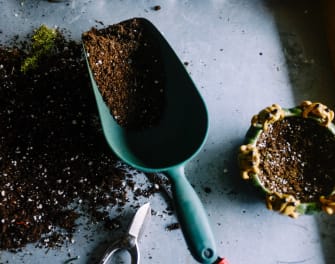In part 2 of our vegetable gardening guide, we discuss transporting, watering and protecting your plants.

Transporting your plants
If you see green sprouts and 3-4 leaves from your plant container, Congratulations, you did it! You have successfully passed a significant milestone and clearly have a green thumb.
Only when the threat of frost is gone should you consider moving your household treasures outside. Usually, the first week of May is a safe time.
Just like your indoor location, the outdoor permanent location for your plants should get at least 6 hours of sunlight and the more the better.
When transporting your plants, take care to preserve as much soil as you can from its original home. Bury deep enough to just cover roots and tamp the soil enough to keep the plant upright. If you’re having a hard time, tomato cages and stakes are ok to use and even encouraged. Once you’re done, it’s time for nature to do her thing!
Watering
By far the biggest mistake we see people make is in the watering process and the tendency is to over hydrate. More is better right? Not so. Overwatering encourages damaging fungus, disease, insects and root rot. Instead, we recommend to water to saturation and let the soil completely dry out before watering to saturation again. Don’t water until you need it. If your soil drains well as it should, expect every couple days. It’s important to note however, there is no set formula. Go ahead and get dirty by sticking your fingers in the soil to determine the moisture content.
Where to put your plants is important too. Leave enough room for your plants to mature and get sunlight on all the leaves. You don’t want plants to compete with one another. If they do, they all will suffer, and you will have more losses than you should.
Beware of critters
Rabbits, moles, squirrels, groundhogs, deer and other critters can devastate your garden in minutes. It’s for that reason, a fence is almost a necessity for all of us. You have a couple options here. A simple chicken wire fence that stands 18-24 inches takes minutes to set up and do the job. If the thought of an unsightly fence makes you cringe, you can use Liquid Fence. This is an organic product that is spread around the garden perimeter. It tricks the animals into thinking predators are nearby.
The first step is to identify the culprit(s). Look for tracks and teeth marks on your plants to determine what countermeasure to use. For example, a chicken wire fence may not be effective to keep out squirrels and a mesh cover might be a better choice. If you have a deer problem, make that fence higher. You could try some low-tech solutions too like planting thorny bushes around the garden perimeter.
Of course, if there is enough competition for food and its scarce, you likely will have at least some damage. We just don’t want to see all beautiful creations get destroyed.
That should keep you busy for now. In our next article we will discuss other garden enemies and the best part of all, harvest season!
From all of us at Decker’s Nursery
